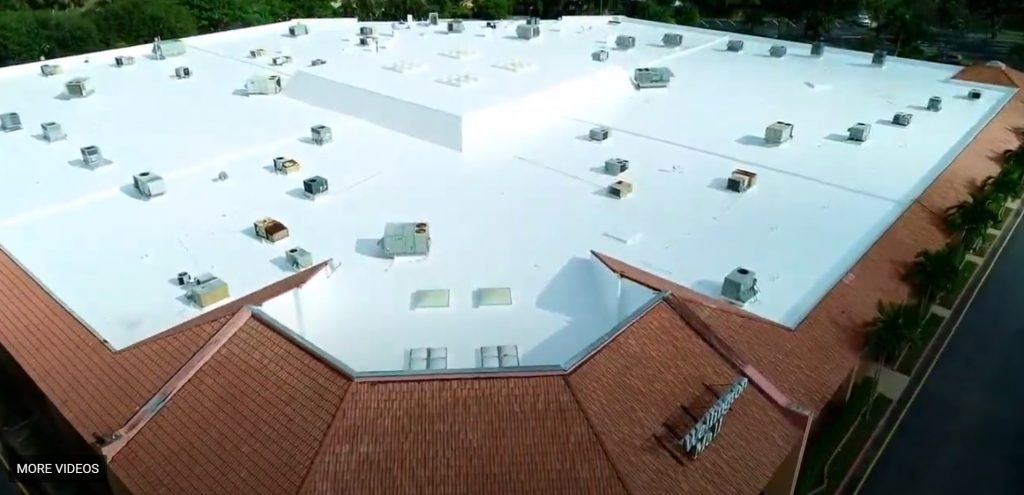In commercial roofing, selecting the ideal system can be daunting. With various options, identifying the one that meets your needs is crucial. Spray foam roofing has emerged as a viable solution, combining durability, energy savings, and ease of maintenance. Unlike traditional roofing systems like built-up roofing (BUR) or single-ply membranes, spray foam, or SPF (Spray Polyurethane Foam), offers a seamless, insulating barrier, enhancing commercial roof performance significantly.
This article compares spray foam roofing with conventional options, focusing on aspects like installation, longevity, and environmental impact. Our aim is to assist property managers and building owners in making informed decisions that protect their investment while promoting sustainability and efficiency. Let’s delve into the benefits and considerations of spray foam roofing versus traditional counterparts.
Benefits of Spray Foam Roofing
Ease of Installation
SPF involves spraying a liquid that expands into foam, forming a seamless layer over the existing roof structure. This reduces installation time, minimizing disruptions to building operations and exemplifying affordable roof coating services.
Superior Insulation
SPF roofing offers superior insulation thanks to its high R-value, which reduces heat transfer and boosts energy efficiency. Buildings with SPF roofs are more energy-efficient compared to those with traditional systems, directly lowering operational costs and providing substantial savings in heating and cooling over time.
Leak Prevention
SPF excels in leak prevention due to its seamless application. Traditional methods often have seams and joints that can leak. With SPF, a watertight seal is created, reducing water infiltration risks and enhancing long-term roof integrity.
Lightweight Nature
SPF is lightweight, making it an ideal solution for retrofitting. Traditional options are often heavier, which can strain building structures. SPF can be applied over most existing roofs without requiring additional structural support or major changes, making it a budget-friendly commercial roofing option.
Durability and Longevity
With proper maintenance, SPF roofs can last several decades, often surpassing traditional systems. This longevity reduces the need for frequent replacements, cutting long-term costs for building owners.
Environmental Benefits of SPF Roofing
Improved Energy Efficiency
SPF’s high insulation properties help decrease energy usage, which translates into lower heating and cooling costs and reduces the building’s carbon footprint.
Reduced Waste
SPF is often applied over existing rooftops, reducing the amount of discarded roofing materials sent to landfills. This aligns with the sustainability goals of environmentally conscious companies.
Maintenance and Adaptability
Straightforward Maintenance
SPF roofing is straightforward to maintain and less costly than traditional systems. Regular inspections allow early issue detection, and minor repairs are often manageable by recoating affected areas. This ease of maintenance contributes to cost-effectiveness over the roof’s life span.
Thermal Adaptability
In climates with variable weather, SPF demonstrates notable adaptability. It contracts and expands with temperature changes, preserving the roof’s structural integrity without cracking or splitting. This resilience makes SPF suitable for regions with fluctuating climates where traditional systems might fail or wear quickly.
Flexibility for Unique Configurations
SPF caters to unique roof configurations and complex building geometries. Its flexibility and application mode provide consistent coverage for roofs with unusual shapes or intricate designs, eliminating the need for custom-fabricated elements typical in traditional methods.
Comparing Costs: Spray Foam vs Traditional Roofing
Upfront Costs
Spray foam roofing can initially cost more than some conventional materials, such as asphalt shingles or metal roofing, due to specialized application equipment and skilled labor. However, traditional systems often involve separate costs for underlayment, fasteners, and additional labor, raising overall expenses.
Long-Term Savings
SPF roofing offers long-term savings due to its energy efficiency and durability. By reducing heating and cooling expenses and requiring less frequent replacements, SPF offsets its higher upfront costs.
Maintenance and Repair
Traditional roofs often need frequent repairs due to weather damage or degradation. SPF roofs, being seamless, are less prone to damage from elements. Necessary repairs are typically quick and less expensive than traditional roofing work.
Environmental Impact of Spray Foam Roofing
SPF roofing is praised for its sustainability, as it combines high insulating properties with the ability to extend the lifespan of existing roofs. This reduces resource usage associated with replacements and minimizes energy consumption for heating and cooling. Traditional systems, on the other hand, often require more frequent replacements and lead to higher energy usage.
Assessing Total Cost of Ownership
It is vital for commercial property decision-makers to consider not only the initial investment but also the total cost of ownership over the roof’s life. By factoring in installation expenses, future energy savings, maintenance, and renewal costs, spray foam roofing frequently offers a competitive cost-performance advantage.
Summary: Why Choose Spray Foam Roofing?
In summary, while spray foam roofing might have higher upfront costs, its performance—such as energy efficiency, reduced maintenance needs, durability, and environmental benefits—can offer better overall value than traditional options. This makes spray foam roofing an appealing choice for those seeking long-term performance and cost savings in commercial roofing solutions.
Frequently Asked Questions
Q1: Is spray foam roofing suitable for retrofitting projects?
Yes, SPF’s lightweight nature and ability to adhere to most existing roofing materials make it ideal for retrofitting. It reduces the need for structural reinforcements and additional modifications.
Q2: How does spray foam roofing handle extreme climates?
SPF expands and contracts with temperature fluctuations, maintaining its structural integrity in extreme climates. This flexibility ensures long-lasting performance in harsh weather conditions.
Q3: What maintenance does spray foam roofing require?
SPF roofing requires minimal maintenance compared to traditional systems. Regular inspections and occasional recoating help maintain its durability and effectiveness.

